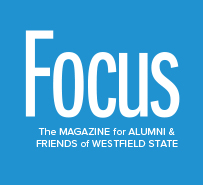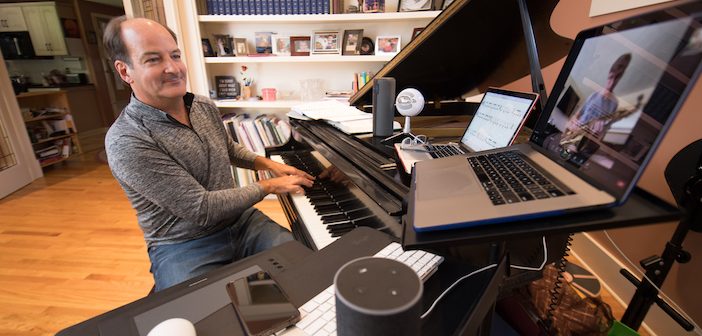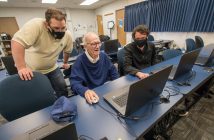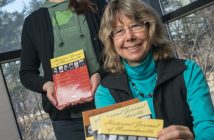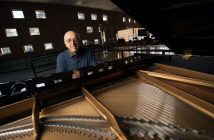By Troy Watkins
As the Coronavirus (COVID-19) pandemic swept across the globe and educators were forced to swiftly transition their courses to an online format, Westfield State responded to the challenge. With the help of the Academic Information Services (AIS) team, faculty, staff, and students concluded a spring semester in a remote working and learning environment they will never forget.
Faculty needed to scrap their in-person teaching methods and develop new plans that incorporated a combination of online instruction platforms, including Zoom, Google Classroom, and Blackboard. Webinars were shared, and emails packed with advice were exchanged to make sure faculty had all the tips they needed to successfully teach students in different way, and in a short amount of time.
Here is a sample of how Westfield State science and music faculty changed course (and their courses) during
the spring 2020 semester.
ENVIRONMENTAL GEOLOGY (GEOL 0205)
No science lab? No worries.
As Tarin Weiss, Ph.D., associate professor of chemical and physical science, explains, “In Environmental Geology, students investigate water quality by first constructing physical models to conceptualize how point- and non-point contamination enters a watershed system.”
Prior to the pandemic, in-class sessions typically included construction of watershed models, and students visited Westfield’s Little River to explore stream morphology and water quality.
“Instead, during this past spring semester, students constructed simple watershed models at home using plain paper and tape,” said Dr. Weiss. “They crumpled paper to build a set of three-to-four watersheds, delineated boundaries, and explored surface run-off and infiltration, using ink from markers, spices, jimmies, or whatever they could find.”
“After building their dry models, they added precipitation and observed how and where the water and added materials flowed,” Dr. Weiss says. “They reflected on the ways their models were conceptually accurate
and inaccurate.”
Following this activity, students investigated their own watersheds and surface water quality using real-time data from Model My Watershed and the Environmental Protection Agency’s (EPA) Water Quality Assessment Reports.
“It seems as though students enjoyed the hands-on aspect of the activity, and their responses bore out that it helped them conceptualize watersheds and contamination sources,” says Dr. Weiss. “And, while learning, I believe you should always get your hands dirty. I know that happened.”
GENERAL CHEMISTRY II (CHEM 111)
Since the molecular models typically used to teach chemistry are on campus, faculty and students were required to get creative in the General Chemistry II course taught by Karsten Theis, Ph.D., professor of chemical and physical science.
“In other natural sciences, if you need an example, you just go outside and look at a tree, or roll a marble down a slope,” say Dr. Theis. “In chemistry, where the molecular objects we study are too small to see even with
a microscope, we resort to molecular model kits.”
Without these kits, students in the course showed their creativity when asked to build a model of the tetrahedral molecule methane (CH4), the main component of natural gas.
“They used fruits, erasers, and tinfoil balls for atoms; and pencils, spaghetti, and skewers for bonds,” says Dr. Theis. “One student asked his housemates to make a human sculpture to resemble the methane molecule. The wider chemistry community chimed in as well, suggesting tying four balloons together.
“Grasping the shape of tetrahedral molecules is the basis for the amazing properties of more complicated molecules, governing, for example, the products of chemical reactions and how drug molecules bind their receptor proteins,” explains Dr. Theis. “This shape has such a significance that one of the main scientific journals is named simply Tetrahedron, so it makes sense to build your own, and learn from it. And when you got it, you can eat it.”
MUSIC
This past spring, millions of individuals watched musicians collaborate and perform concerts via live and recorded sessions on primetime television, digital streaming channels, and social platforms. Westfield State student musicians jumped on the bandwagon and shared their talents as well. In April, Music Department students teamed up remotely to sing the famous tune, “Anything You Can Do (I Can Do Better)” from the 1946 Broadway musical “Annie Get Your Gun.”
“The abrupt shift to fully remote teaching was truly a challenge for all of us, especially for an activity so steeped in interpersonal engagement as music-making,” said Andrew Bonacci, D.M.A., professor and chair of the Music Department. “The experience, however, has come with a silver lining—in our need to find new ways of engaging musically with one another, we’ve discovered new technologies and techniques that will no doubt inform our teaching in positive ways for years to come.”
